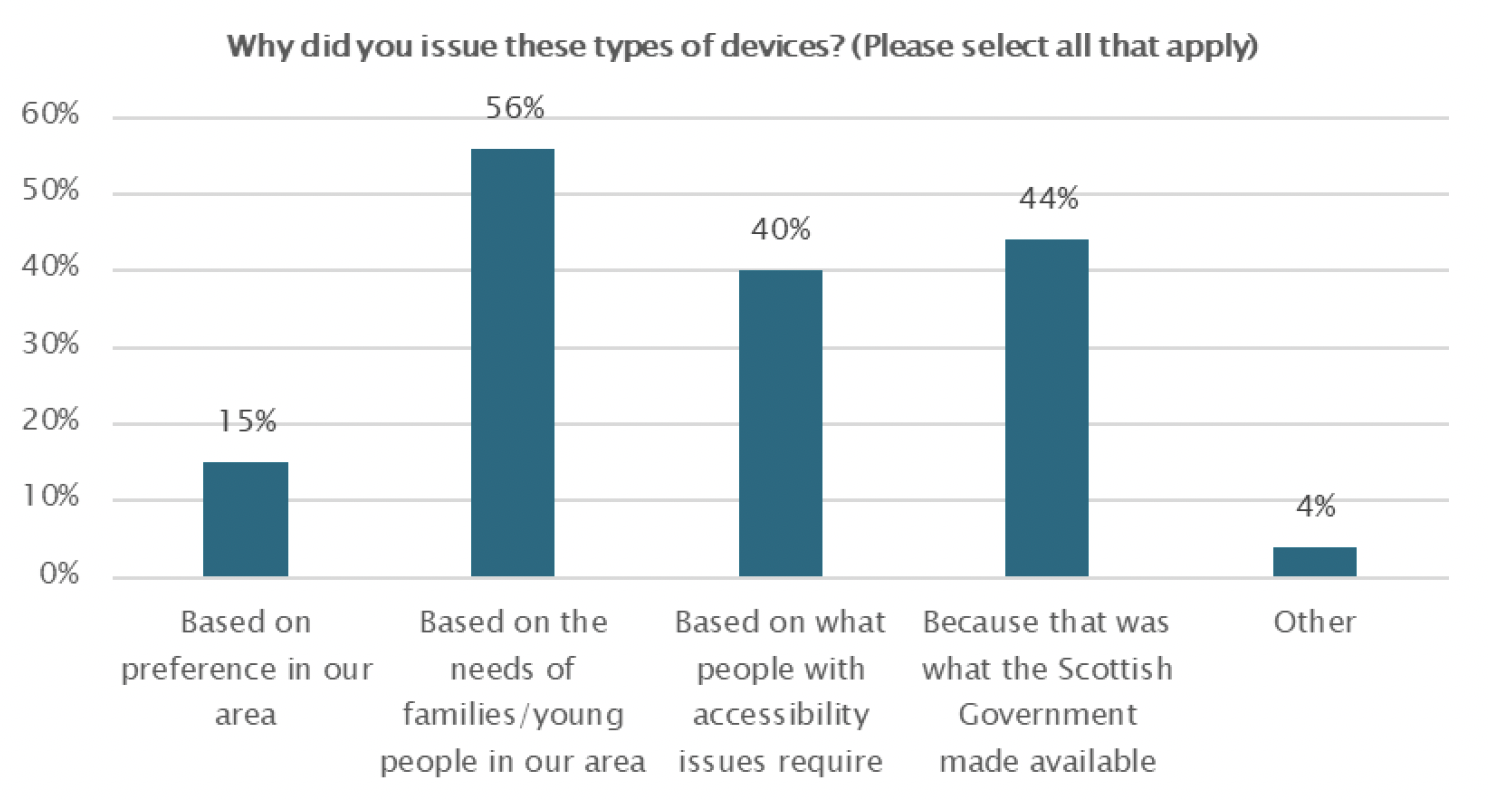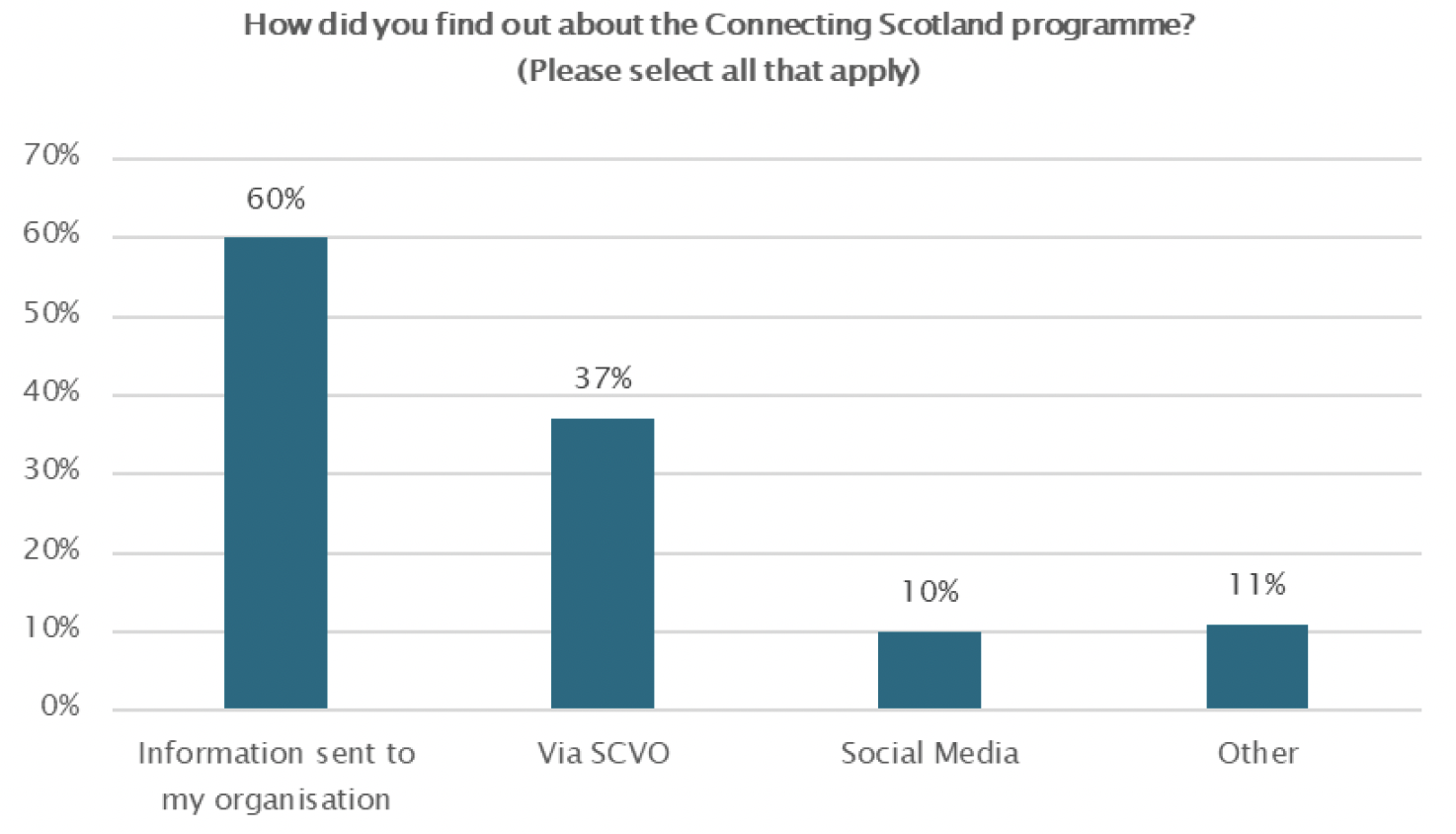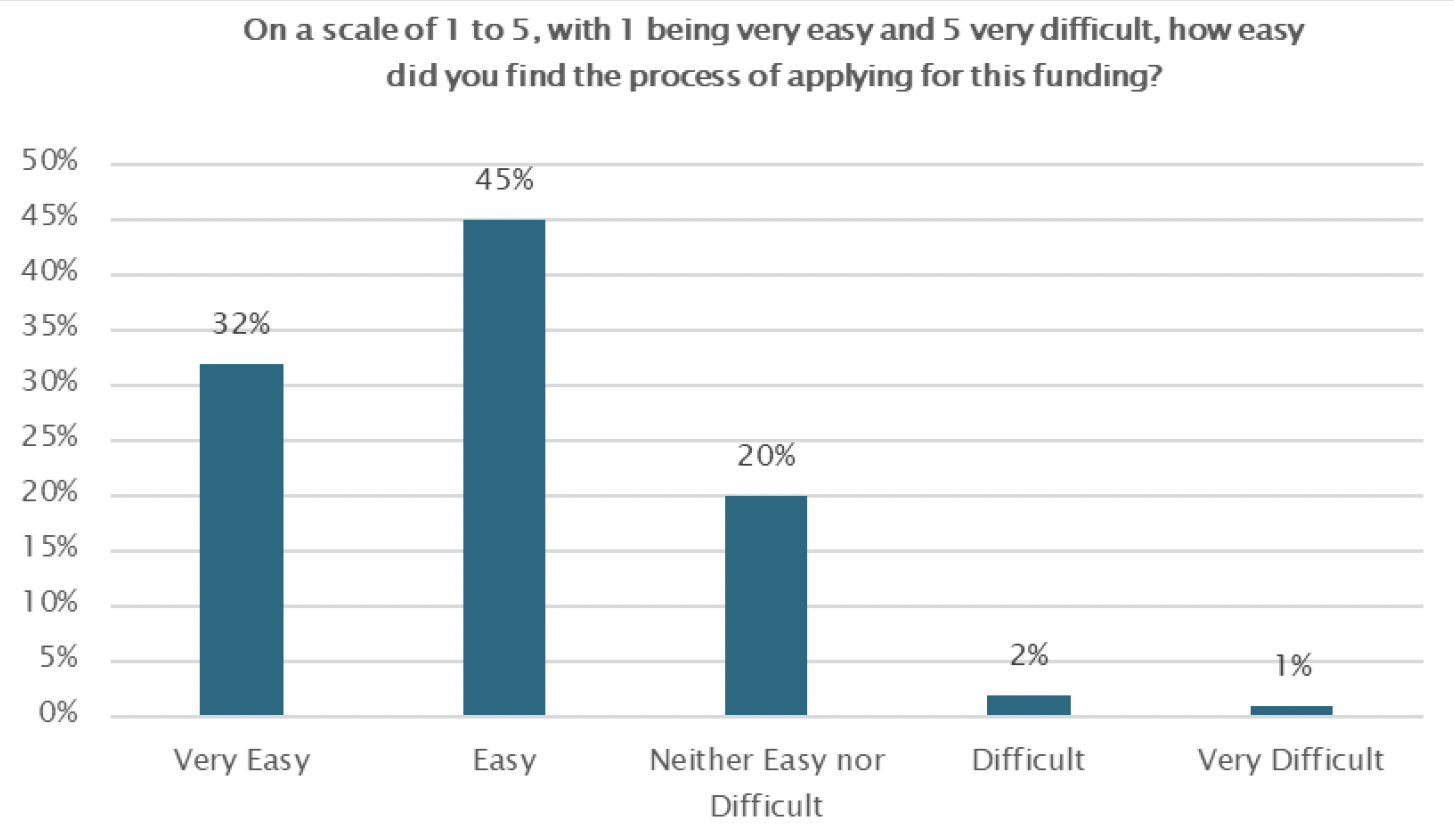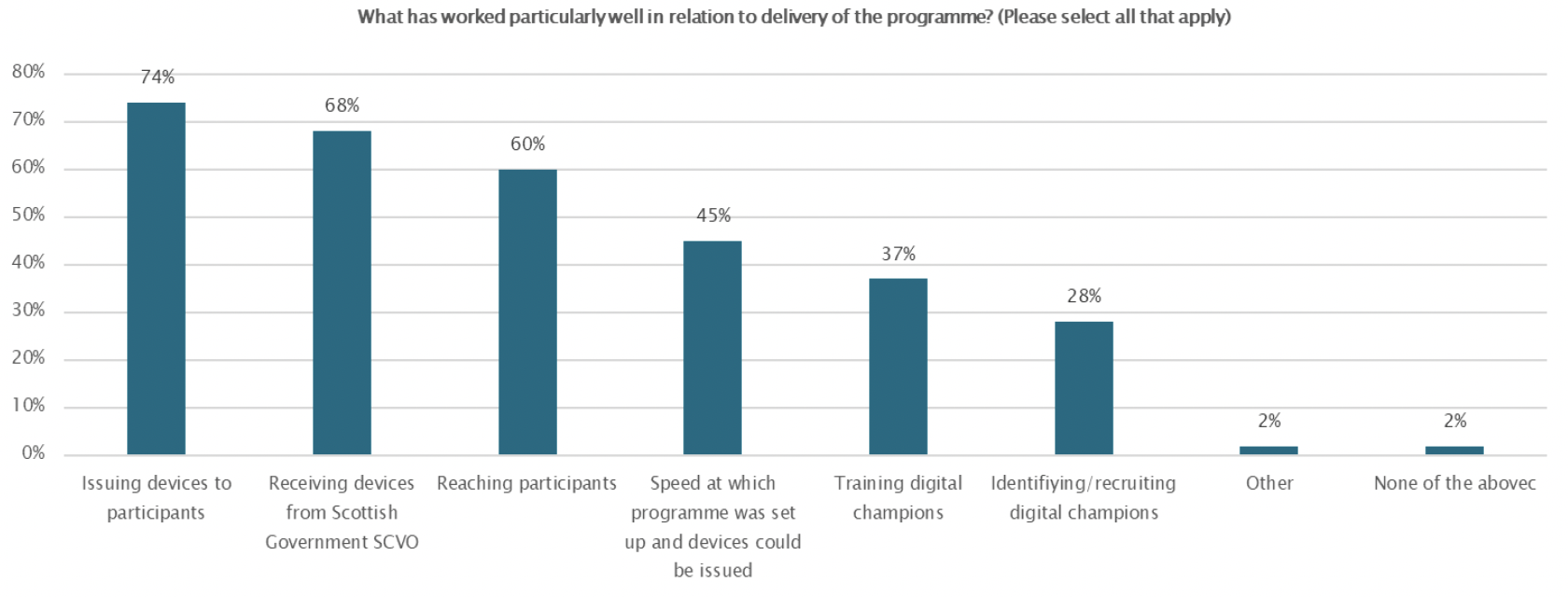Connecting Scotland - evaluation: qualitative research - implementation and early impact
Findings of research with organisations who applied for digital devices, through the Connecting Scotland programme, to distribute to people that they support.
Appendix 4 Summary Survey Findings
Connecting Scotland
Data from survey of applicants
547 of those who applied for funding from Connecting Scotland completed the survey.
Background Information
Location of Organisation
The number of organisations for each location and as a percentage of all organisations, from highest to lowest:
- Glasgow: 89 (16.3%)
- Edinburgh: 57 (10.4%)
- Fife: 41 (7.5%)
- Scotland-wide: 37 (6.8%)
- North Lanarkshire: 32 (5.9%)
- Dundee: 29 (5.3%)
- Falkirk: 29 (5.3%)
- Renfrewshire: 28 (5.1%)
- Highland: 25 (4.6%)
- Stirling: 23 (4.2%)
- North Ayrshire: 23 (4.2%)
- South Lanarkshire: 22 (4.0%)
- West Lothian: 21 (3.8%)
- Perth & Kinross: 19 (3.5%)
- East Lothian: 19 (3.5%)
- East Ayrshire: 18 (3.3%)
- Orkney: 17 (3.1%)
- Clackmannanshire: 16 (2.9%)
- Dumfries and Galloway: 15 (2.7%)
- South Ayrshire: 15 (2.7%)
- West Dunbartonshire: 15 (2.7%)
- Moray: 15 (2.7%)
- Angus: 14 (2.6%)
- Midlothian: 13 (2.4%)
- East Renfrewshire: 13 (2.4%)
- Aberdeen City: 12 (2.2%)
- Argyll & Bute: 12 (2.2%)
- Scottish Borders: 11 (2.0%)
- East Dunbartonshire: 10 (1.8%)
- Aberdeenshire: 10 (1.8%)
- Inverclyde: 7 (1.3%)
- Eilean Siar: 4 (0.7%)
- Shetland Islands: 1 (0.2%)
Size of Organisation
- 30% of respondents represent an organisation of up to 9 employees
- 26% between 10 and 49 employees
- 18% between 50 and 249 employees
- And 30% with over 250 employees
- Only 0.4% (2) with no employees
Phase Involvement
- 63% of respondents were involved with Phase 2
- 31% were involved with Phase 1
- 25% were involved with the Winter Support Package
- 4% were unsure which phase they were involved with
- These were split across a number of locations
- 4% were unsuccessful with their application(s)
- 4% equates to 23 participants. 9 of the 23 were in Glasgow, where (10%) were unsuccessful with their applications
Number of Participants Supported
- Respondents have supported 16,411 participants by providing a WiFi connection
- Respondents have supported 23,069 participants by providing a device
- Respondents have supported 26,344 participants by providing support and advice
Type of Participants Supported
The number of participants supported by type and as a percentage of overall number of participants:
- Low income families: 344 (66%)
- People shielding 221: (42%)
- People in the higher risk of severe illness: 191 (37%)
- Disabled people 60 years old or over: 185 (24%)
- People aged 60 years or over (not disabled): 181 (34%)
- Disabled people under 60 years old: 177 (35%)
- Young care leavers: 126 (35%)
- Other (please specify): 109 (21%)
- 4 Participants selected all 8 of the above options
- 27 Participants selected 7 options
- 60 Participants selected 6 options
- 98 Participants selected 5 options
Urban or Rural
46% of participants lived in an urban area, 38% lived in an area that was both urban and rural, 17% lived in a rural area.
Devices Issued
Number of Devices Issued
- Participant organisations have issued 10,410 iPads
- Participant organisations have issued 12,736 Chromebooks
Why These Devices Were Issued

Application Process
Discovery of Connecting Scotland

Ease of Funding Process

Support Provided
- 96% agreed there was adequate support provided during the application process
- The other 4% (22) were divided across most locations
- When asked what support was needed but they were unable to access, all 22 entered a response – all are listed below:
- We are a small charity and don't employ people. However, we work with the community and support where possible
- emailed but was never responded to. wanted some clarity about the process.
- All
- Information about future phases to submit appropriate request.
- Communication with process of applying.
- I made a mistake of putting the wrong building number for delivery but despite several attempts got no response to say this had been sported which was quite stressful as it due to Covid lockdown the items were to be delivered to my home address. One was sorted one was not
- We weren't successful and we weren't then given any support to reapply
- Links for non 3rd sector or public body organisations
- clearer understanding of the criteria
- We needed more information to work out eligibility
- More clarity about what fund was and what peramiters for applying?
- Unaware of option to ask for cromebooks and the mifi devices where requested but not registered as being asked for
- I was not aware of any.
- There was no feedback as to why we weren't successful in both occasion. And we thought all questions were answered as asked
- We had absolutely no support in researching, applying for funding, no constructive feedback as to how we could get into the "loop". We were late in finding out about the funding (not in applying), and were advised that most of the grants had been allocated in the previous phase as an explanation as to why we were unsuccessful.
- We work with highly deprived community and we got nothing and felt let down because we had made a big promise to these vulnerable groups that the Scottish government through connecting Scotland will provide them with devices.
- Guidance for the Application did not inform of all the relevant conditions of applying. This was not related until the Agreement signing stage.
- getting in touch with the proper people
- We requested 40 items and received 30 to support people across 2 local authority areas
- We were not aware that we could have asked for support with the application form.
- I wasn't aware how fiddly it was doing applications for each local authority area. It would have been much easier doing one application. And the data gathering logistics bit was difficult during the pandemic as it wasn't clear about matching the sim numbers with the local authority CS code with the iPad or chrome books. This wasn't spelt out to us. The pandemic caused all kinds of problems with our teams were working from home, and only two members of staff at the centre. It was a bit of a struggle but we managed it in the end.
Clarity of Concept
- 46% found the concept of Connecting Scotland very clear from the outset
- 42% found it quite clear
- 9% found in neither clear nor unclear
- 2% found it difficult to understand
- 0.4% (2) found it very difficult to understand
- None of the selections were favoured by any particular location
Reason for Unsuccessful Application
- 24 Respondents entered a selection, of which
- 30% were unsuccessful due to the programme being over-subscribed or insufficient funds
- 26% because their application did not fit with the criteria of the programme
- 22% did not receive any feedback with a reason
- 26% had another reason:
- we were told it was for shielding people, which was interesting since most of our people were shielding
- We didn't receive any funding for devices as we are not a 3rd party or public body. This was a tragedy for those we support who have been left isolated especially throughout the pandemic.
- Duplication. My application was rejected as the authority also applied.
- "Thanks for your interest in the Connecting Scotland programme in Stirling. We are sorry but we are unfortunately unable to support your request at this time. Stirling Council operated a closed application process and received a large amount of eligible requests for the number of devices available. We do appreciate the particular needs of your service users. If they haven't already looked, please encourage the families you support to make contact with their school settings as there may be scope to get devices through the Education strand of Connecting Scotland."
- I don't remember.
- 2 applications submitted, only received feedback for one. This said we had not indicated we had IT support but this was included in our application text.
Other Comments
- When asked for other comments, 11 responses were received:
- Nobody seems to care for this group and despite requests to Edinburgh health and social partnership for assistance none has been forthcoming. My feedback to the government would to allow care companies to apply on behalf of those they support if they really want to expand access to the most vulnerable in society.
- we applied in the first round and received an "already over subscribed" rejection. it would have been bettter to close the applications rather than allow people to waste time. in the second application we were again told that due to over subscription we were rejected as we didn't meet the critieria under "other vulnerabilities" (our work is with destitute asylum seekers who have no right to work or claim benefits, nor access homelessness support.
- The authority was able to secure devices of which we benefited. It has made a positive impact for our families. Children are able to complete homework online, communication between home and school has improved, parents have used their devices to attend online school meetings, attend online Social Work and Scottish Reporter meetings and attend authority NVR (Non Violent Resistance) parenting classes.
- We deal with very vulnerable people with addiction and blood borne virus issues. I was told that we were unsuccessful as they were not families ( I am sure that some of them do have families)
- We are continuing to grow and develop the MorphFit model and connecting more populations online to the MorphFit Gentle Movement Programme. We would like to be considered if there is any future funding available.
- I did feed back at the time that the eligibility seemed to change between application and feedback.
- We found this answer very disappointing, we were supporting families who did not have any devices and whom we could not access devices for - Stirling Council included. Young people and young adults with disabilities, struggled massively during the pandemic and still are. We did not apply again as we did not see the point with such a poor response.
- I do not have enough information to comment.
- I think it was for selected people. And those were the organisation that were successful.
- Basically a good idea, but there is a chasm to cross in terms of inclusion , safety-nets and the input - or rather - lack of - support from the local authoriy. Notwithstanding that, even a hint of interest in the group would have been nice.
- I am now waiting to hear back from someone after contacting my local MP who seems to be pointing me in the right direction
Would They Apply Again?
- When asked if they would apply again, only 23 responded
- 61% said they would apply again
- Their comments on why:
- I feel that there are people who can benefit greatly from this help
- Some families in my service still have no access to IT equipment and with computer and video appointments staying it is difficult for the families to connect with the service
- Because we still have people who require some connectivity
- We had previously been successful with receiving Tablets from Barclays bank and as they supported a limited number of people we work with more to allow more individuals connect with family, friends etc.` would have been appreciated
- The impact on individual families has been very positive.
- I did apply to Fairer Falkirk Covid-19 Digital Exclusion Fund in March and were approved in April. The funds have just come into our account. I am disappointed that there is no guidance on making the purchases. If a deal was available negotiated centrally for all with a specific provider this would be much easier.
- I have applied again because our organisation really need the devices for our service users to attend our online zoom activities.
- People still need support to access online services/support/contact with outside world etc.
- I would apply again as I think it will help a lot of people
- This organisation is linked to the beneficiaries who require to become digitally savvy. However they all require one to one training and its whether or not their personal health allows them to undertake the training over the funded time span is the reason why this organisation cannot define recipients in advance.
- If our clients have a need, we will always try to access help for them.
- I will continue to work for the service users we have to help them gain access to technology that could help them in so many ways.
- 39% said they would not apply again
- Their comments on why not:
- Disappointing - had to source other resources
- We got funding through the LA to support our young people and families
- Unless the criteria changes to support organisations such as care providers then there is no point in applying
- Too difficult to work out the eligibilty criteria and moving goal posts
- as above
- It was a one-time requirement due to isolation, and concern that some of our young members could not connect to online meetings due to financial hardship.
- I'm not sure that we will still be here and be viable as a group. We have lost 2 members through death and ill-health. Our C E Centre is still closed to us. Most of our paints and papers will be unusable.
Implementation
Ease of Implementation
- 49% of respondents found the implementation of the programme either easy or very easy
- 21% very easy and 28% easy
- 44% had some challenges with the implementation of the programme
- 7% found it difficult of very difficult
- 2% very difficult and 5% difficult
Digital Champions
- When asked how many digital champions were in their organisation:
- 53 respondents did not give an answer or stated n/a or zero
- There were an average of 4.4 per organisation
- The maximum for any one organisation was 68
- When asked if the digital champions were already in place:
- 63% already had them in place
- 20% had to recruit them
- 17% had some in place and had to do some recruitment
- When asked if the recruitment of digital champions caused delays:
- 85% said no
- 15% said yes
- When asked how easy it was to accommodate digital champion training:
- 68% found it either easy or very easy
- 44% easy and 24% very easy
- 28% found it neither easy nor difficult
- 5% found it either difficult or very difficult
- 4% difficult and 1% very difficult
- When asked to what extent the training adequately equipped the digital champions to undertake their role:
- 63% said to some extent
- 30% said to a great extent
- 7% said not at all
What Has Worked Well?

Barriers
- When asked if there had been any barriers to implementation, 378 entered a response. Of these:
- o 89 entered no, none, n/a or similar
- o 76 mentioned COVID or Lockdown
Programme Reach
Reaching Out to Clients
- 524 responses were received when asked if they reached to clients before or after receiving devices
- 67% before
- 33% after
- 175 responses were received when asked if this delayed implementation of the programme
- 67% no
- 33% yes
Programme Impact
The number, and percentage, of organisational respondents identifying specific outcomes, for participants, of the Connecting Scotland programme from most to least. Participants could select multiple options:
- They have a device to access the internet: 473 (90%)
- Better able to stay in touch with friends and family: 456 (87%)
- They have a WiFi connection: 452 (86%)
- Improved wellbeing: 416 (79%)
- They have gained IT skills: 389 (74%)
- Improved mental health: 386 (74%)
- They are more connected with local services: 371 (71%)
- They can access advice and guidance on important issues: 323 (62%)
- They are more engaged with their local community: 308 (59%)
- Family members benefitted from Connected Scotland devices: 292 (56%)
- Able to access public services such as the benefits system: 287 (55%)
- Able to access health services: 270 (52%)
- They are better able to engage with their children's education: 269 (51%)
- They can search and apply for jobs: 246 (47%)
- They are more employable: 143 (27%)
- Able to save money on bills: 125 (24%)
- Other: 61 (12%)
- Have made money online (e.g. through selling things): 17 (3%)
- None of the above: 3 (1%)
What Impact Has the Programme Had?
- 1 respondent selected all 18 options (excluding none of the above
- 48 selected 17 of the 18 options
- 77 selected 16 of the 18 options
Impact Evaluation
- 82% carried out impact evaluation
- 18% did not
Delivery Process
Inputting Data into SCVO System
- 71% did not have any challenges
- 29% had challenges
- Of those that had challenges, 150 entered a comment. Some typical examples are:
- It wasn't made clear what type of data we would need to collect from recipients before inputting data - knowing this in advance would have made the process quicker and less clunky.
- Importing from the excel sheet didn't work. Had some issues with the login when tried to access it later. Couldn't check what had input already.
- with phase one, we distributed devices without noting serial numbers, when we discovered we needed these for inputting we have some difficulties getting clients to find and report the numbers back to the digital champions to input, partly due to Covid restrictions and partly because of the nature of our young client group. this improved during the second phase, we noted device, sims and mifi serial numbers before distributing but then had some delivery issues. both these challenges continue to some extent
- It was not clear to capture the numbers on the Mifi and chromebook device from the box. The link was unstable then it was changed I put in approximately 35 individual families received there was no admin support but I mananged didn't know you can just put missing but it didn't seem to accept the details therefore missing information to Connecting Scotland.
- The original system was quite difficult to navigate and then the system used was changed
- System is very prescriptive and does not allow for a more bespoke reporting for each person as each client does not technically fit in all boxes neatly. Also, having set up our own systems to record clients data, it felt like duplication as could not simply copy and paste. This was a little time consuming.
- Some times the system crashed. I was able to upload the spreadsheets finally what was really useful and the best way to do it. I think uploading the spreadsheet instead of manually input the data works better.
- The database had a number of glitches in it, this improved when a new online form for inputting data was implemented.
- I am still uncertain if all of the data has been stored effectively despite updating the system several times. It has been quite stressful and frustrating
- there was issues with the bulk upload systems which were rectified
- Phase 1 - spreadsheet bulk upload didn't seem to really work. Phase 2 - individual upload was a pain to enter every time, particularly around childrens ages having to be entered for every age group.
- Had to enter all data individually. There was no confirmation that each piece of data had been received.
- Length of time and cumbersome to input by having to include ages etc. No technical issues experienced.
- The log in did not remember organisation/user details so a lot of time was spent re-entering.
- Ha change of process caused a little confusion but we got there.
- In the first phase, we didn't take a note of serial numbers of devices before giving them out so it was difficult to get these retrospectively
- There was no place to import upload data from a spreadsheet from phase 2. This would have saved an incredible amount of time.
- Due to the lockdown and being furloughed I had to rely on Council workers to distribute devices and enter details of families onto the web portal and this has been patchy so far.
- duplicated requests for information to be sent
- The difficulty came in receiving the link, not in using the link. Sometimes it went to the wrong person or it was cutting it fine to input data.
- Would not accept a group upload - had to insert details individually
- We had inputted information, and where asked where the info was.
- Not sure how or when to access the area to input data.
- Due to the withdrawal of our digital champion we didn't have access to a lot of the information required.
- The information was repetitive it could have all have been collected on one spreadsheet. There was problems uploading the information Once I finally managed to upload it, I keep getting emails asking me to upload. It makes me think its been a bit problematic.
- Of those that had challenges, 150 entered a comment. Some typical examples are:
Impact On Your Organisation
Creating a Digital Inclusion Officer Post
- 94% responded that the programme did not result in them creating a Digital Inclusion Officer Post in their organisation
- 6% responded that it did
- The 6% were quite evenly divided across different locations
Developing Digital Inclusion Provision
- The programme has helped 81% advance their organisation's digital inclusion provision
- It has not helped 18% to do so
How to access background or source data
The data collected for this <statistical bulletin / social research publication>:
☐ are available in more detail through Scottish Neighbourhood Statistics
☐ are available via an alternative route <specify or delete this text>
☐ may be made available on request, subject to consideration of legal and ethical factors. Please contact <email address> for further information.
☒ cannot be made available by Scottish Government for further analysis as Scottish Government is not the data controller.
Contact
Email: CSresearch@gov.scot
There is a problem
Thanks for your feedback